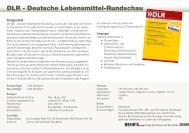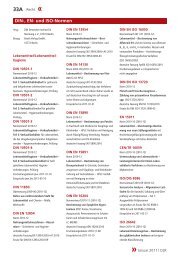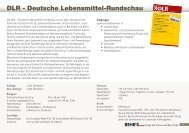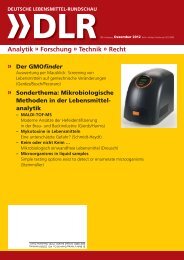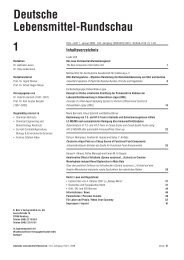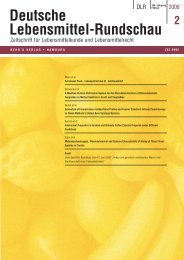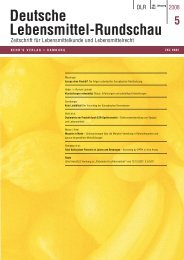Nanotechnologie in Lebensmitteln - DLR Online: Deutsche ...
Nanotechnologie in Lebensmitteln - DLR Online: Deutsche ...
Nanotechnologie in Lebensmitteln - DLR Online: Deutsche ...
Sie wollen auch ein ePaper? Erhöhen Sie die Reichweite Ihrer Titel.
YUMPU macht aus Druck-PDFs automatisch weboptimierte ePaper, die Google liebt.
52<br />
Orig<strong>in</strong>alarbeiten «<br />
Tab. 1 Heavy metals content (µg/l) of some Croatian w<strong>in</strong>es<br />
Brand of Location Year FTSCP FAAS GFAAS<br />
w<strong>in</strong>e<br />
(Mean ± SD) (Mean ± SD)<br />
Zn Cu Pb<br />
White<br />
Cd Zn Cu Pb Cd<br />
Hvarsko<br />
bijelo<br />
Hvar Dalmacija 2005 314.3±10.8 37.8±1.5 33.17±2.05 0.17±0.03 311±12 40±3 35.52±2.16 0.15±0.03<br />
Rizl<strong>in</strong>g Mandić evac<br />
Slavonija<br />
2006 445.4±18.9 150.3±7.1 9.43±0.82 0.25±0.07 453±23 144±9 8.95±0.70 0.22±0.06<br />
Grašev<strong>in</strong>a Kutjevo<br />
Slavonija<br />
2005 503.5±9.6 10.3±1.3 9.44±0.87 0.15±0.04 502±15 10±2 8.28±0.96 0.11±0.03<br />
Grašev<strong>in</strong>a Banovo Brdo<br />
Baranja<br />
2005 959.5±16.8 245.7±2.6 16.61±1.05 0.18±0.05 946±21 252±8 15.70±1.13 0.14±0.04<br />
Tram<strong>in</strong>ac Ilok Srijem 2005 673.7±10.6 404.0±12.0 5.31±0.43<br />
Rosé<br />
0.12±0.03 683±14 413±16 4.39±0.57 0.10±0.03<br />
Rose Benkovac 2006 687.0±15.5 185.5±5.2 23.69±1.27 0.10±0.03 680±18 193±6 25.47±1.35 0.09±0.03<br />
Benkovac Dalmacija<br />
Red<br />
Zweigelt Erdut Slavonija 2006 674.6±20.1 129.8±3.3 5.41±0.72 0.05±0.03 690±23 126±4 6.51±0.61 0.05±0.03<br />
Frankovka Orahovica<br />
Slavonija<br />
2005 648.6±15.6 131.0±3.4 8.57±0.81 0.13±0.03 630±17 130±6 7.82±0.84 0.10±0.03<br />
Frankovka Ferić anci<br />
Slavonija<br />
2006 492.9±10.8 107.4±2.5 6.17±0.78 0.09±0.03 483±12 100±3 6.26±0.73 0.10±0.03<br />
P<strong>in</strong>ot Noir Kutjevo<br />
Slavonija<br />
2006 1176±26.6 264.6±4.0 8.50±0.95 0.06±0.03 1180±35 271±6 7.99±0.69 0.06±0.03<br />
Klikun Noir Kutjevo<br />
Slavonija<br />
2005 455.3±11.4 139.9±2.8 9.07±0.93<br />
Fruit W<strong>in</strong>e<br />
0.18±0.04 463±13 148±4 8.13±0.97 0.16±0.04<br />
Blackberry Ðakovo 2005 574.7±12.5 47.3±2.3 9.17±0.97 0.16±0.04 563±14 44±3 8.34±0.80 0.15±0.04<br />
w<strong>in</strong>e 1 Slavonija<br />
Blackberry Požega 2005 720.3±18.3 146.5±3.5 14.44±1.58 0.13±0.03 710±21 140±8 12.87±1.30 0.10±0.03<br />
w<strong>in</strong>e 2 Slavonija<br />
Comparison of our results to those of previously reported<br />
<strong>in</strong> the literature show the follow<strong>in</strong>g. Our results that Cu<br />
content <strong>in</strong> <strong>in</strong>vestigated w<strong>in</strong>es ranged from 10 to 413 μg<br />
Cu/l are generally <strong>in</strong> agreement with the results of: Karadjova<br />
et al. 15) (they measured Cu content from 160–460 μg<br />
Cu/l, <strong>in</strong> some Macedonians, Bulgarians and Turkish w<strong>in</strong>es,<br />
Šperkova and Suchanek 22) (reported mean content of Cu<br />
from 45–260 μg Cu/l <strong>in</strong> some w<strong>in</strong>es from Czech Republic,<br />
Catar<strong>in</strong>o et al. 24) (they found between 44 and 237 μg Cu/l<br />
<strong>in</strong> some Portuguese white and red w<strong>in</strong>es), Bra<strong>in</strong><strong>in</strong>a et al. 26)<br />
(they analysed w<strong>in</strong>es on Russian market and found between<br />
25 and 185 μg Cu/l. Some authors reported higher<br />
concentration of Cu <strong>in</strong> w<strong>in</strong>es, like e.g. Coetzee et al. 23)<br />
(from 178–600 μg Cu/l <strong>in</strong> South African w<strong>in</strong>es), Šebečić et<br />
al. 14) (between 90 and 930 μg Cu/l <strong>in</strong> some Croatian w<strong>in</strong>es),<br />
Garcia-Esparza et al. 21) (reported that the mean Cu content<br />
found <strong>in</strong> red and white Italian w<strong>in</strong>es was 710 and 1010 μg<br />
Cu/l), and Dugo et al. 27) (between 600–900 μg Cu/l <strong>in</strong> some<br />
Sicilian w<strong>in</strong>es). However, <strong>in</strong> some papers significantly<br />
lower values of Cu content were reported; e.g. <strong>in</strong> paper of<br />
Lara et al. 17) , from 23–28 μg Cu/l <strong>in</strong> some Argent<strong>in</strong>a w<strong>in</strong>es.<br />
Such a great differences <strong>in</strong> Cu content of w<strong>in</strong>es <strong>in</strong> papers of<br />
different authors were probable (ma<strong>in</strong>ly) due to great differences<br />
of grape, must and w<strong>in</strong>e production conditions<br />
(type of soil, different pesticides, fertilizers and chemicals<br />
used dur<strong>in</strong>g the grape production, different w<strong>in</strong>emak<strong>in</strong>g<br />
technology used, etc.).<br />
The content of Cu <strong>in</strong> w<strong>in</strong>e may be expla<strong>in</strong>ed by the natural<br />
sources as well as those related to the production processes.<br />
Natural Cu come from the soil via the roots to the<br />
grapes and f<strong>in</strong>ally to w<strong>in</strong>e and the content of Cu <strong>in</strong> w<strong>in</strong>e<br />
from this source significantly depend on type of soil. Second<br />
and ma<strong>in</strong>ly source of Cu <strong>in</strong> w<strong>in</strong>e are: different agrochemical<br />
products used <strong>in</strong> grapes production as <strong>in</strong>secticides<br />
and fungicides as well as fertilizers (which conta<strong>in</strong>ed copper),<br />
the use of CuSO 4 for the removal of hydrogen sulfide<br />
and other sulfidic off-odours dur<strong>in</strong>g v<strong>in</strong>ification procedure,<br />
the contact of grapes, must and w<strong>in</strong>e with Cu-based equipment<br />
dur<strong>in</strong>g w<strong>in</strong>emak<strong>in</strong>g process, etc. Copper, at low concentration,<br />
is important <strong>in</strong> the fermentative process of<br />
w<strong>in</strong>e, while at higher concentration negatively <strong>in</strong>fluence<br />
the quality of w<strong>in</strong>e, particularly on its organoleptic proper-<br />
» November/Dezember 2008 | <strong>DLR</strong>




